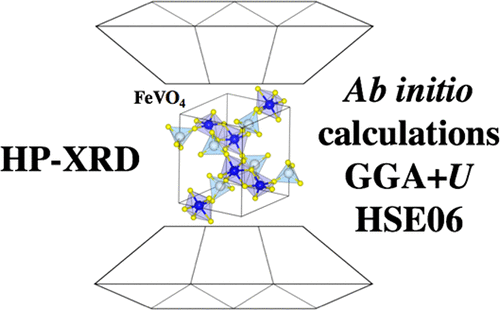当前位置:
X-MOL 学术
›
Inorg. Chem.
›
论文详情
Our official English website, www.x-mol.net, welcomes your
feedback! (Note: you will need to create a separate account there.)
Stability of FeVO4 under Pressure: An X-ray Diffraction and First-Principles Study
Inorganic Chemistry ( IF 4.3 ) Pub Date : 2018-06-13 00:00:00 , DOI: 10.1021/acs.inorgchem.8b00984 Sinhué López-Moreno 1 , Daniel Errandonea 2 , Julio Pellicer-Porres 2 , Domingo Martínez-García 2 , Sadeque J. Patwe 3 , S. Nagabhusan Achary 3 , Avesh Kumar Tyagi 3 , Placida Rodríguez-Hernández 4 , Alfonso Muñoz 4 , Catalin Popescu 5
Inorganic Chemistry ( IF 4.3 ) Pub Date : 2018-06-13 00:00:00 , DOI: 10.1021/acs.inorgchem.8b00984 Sinhué López-Moreno 1 , Daniel Errandonea 2 , Julio Pellicer-Porres 2 , Domingo Martínez-García 2 , Sadeque J. Patwe 3 , S. Nagabhusan Achary 3 , Avesh Kumar Tyagi 3 , Placida Rodríguez-Hernández 4 , Alfonso Muñoz 4 , Catalin Popescu 5
Affiliation

|
The high-pressure behavior of the crystalline structure FeVO4 has been studied by means of X-ray diffraction using a diamond-anvil cell and first-principles calculations. The experiments were carried out up to a pressure of 12.3 GPa, until now the highest pressure reached to study an FeVO4 compound. High-pressure X-ray diffraction measurements show that the triclinic P1̅ (FeVO4-I) phase remains stable up to ≈3 GPa; then a first-order phase transition to a new monoclinic polymorph of FeVO4 (FeVO4-II′) with space group C2/m is observed, having an α-MnMoO4-type structure. A second first-order phase transition is observed around 5 GPa toward the monoclinic (P2/c) wolframite-type FeVO4-IV structure, which is stable up to 12.3 GPa in coexistence with FeVO4-II′. The unit cell volume reductions for the first and second phase transitions are ΔV = −8.5% and −13.1%. It was observed that phase transitions are irreversible and both high-pressure phases remain stable once the pressure is released. Calculations were performed at the level of the generalized gradient approximation plus Hubbard correction (GGA+U) and with the hybrid Heyd–Scuseria–Ernzerhof (HSE06) exchange-correlation functional in order to have a good representation of the pressure behavior of FeVO4. We found that theoretical results follow the pressure evolution of structural parameters of FeVO4, in good agreement with the experimental results. Also, we analyze FeVO4-II (orthorhombic Cmcm, CrVO4-type structure) and -III (orthorhombic Pbcn, α-PbO2-type structure) phases and compare our results with the literature. Going beyond the experimental results, we study some possible post-wolframite phases reported for other compounds and we found a phase transition for FeVO4-IV to raspite (monoclinic P21/c) type structure (FeVO4-V) at 36 GPa (ΔV = −8.1%) and a further phase transition to the AgMnO4-type (monoclinic P21/c) structure (FeVO4-VI) at 66.5 GPa (ΔV = −3.7%), similar to the phase transition sequence reported for InVO4.
中文翻译:

FeVO 4在压力下的稳定性:X射线衍射和第一性原理研究
FeVO 4晶体结构的高压行为已通过使用金刚石-砧室的X射线衍射和第一性原理计算得到了研究。在最高12.3 GPa的压力下进行实验,直到现在达到研究FeVO 4化合物的最高压力。高压X射线衍射测量结果表明,三斜晶系P 1(FeVO 4 -我)相保持稳定达≈3GPA; 然后一阶相变到FeVO的一个新的多晶型的单斜4(FeVO 4 - II' ),空间群C ^ 2 /米观察到,具有α-MnMoO 4型结构。在5 GPa左右向单斜晶(P 2 / c)钨铁矿型FeVO 4 - IV结构观察到第二阶相变,与FeVO 4 - II'共存时,该结构稳定至12.3 GPa 。第一和第二相变的单位晶胞体积减少为ΔV= -8.5%和-13.1%。观察到相变是不可逆的,并且一旦释放压力,两个高压相都保持稳定。在广义梯度近似加Hubbard校正(GGA + U)和混合Heyd-Scuseria-Ernzerhof(HSE06)交换相关函数,以便很好地表示FeVO 4的压力行为。我们发现理论结果遵循FeVO 4结构参数的压力演化,与实验结果吻合良好。另外,我们分析FeVO 4 - II(斜方晶系CMCM,CRVO 4型结构)和-三(斜方晶系Pbcn,α-PBO 2型结构)阶段,并将我们的结果与文献进行比较。超出实验结果,我们研究了其他化合物报道的某些可能的硅灰石后相,并发现在36 GPa时FeVO 4 - IV转变为锂铁矿(单斜晶P 2 1 / c)型结构(FeVO 4 - V) (ΔV = -8.1%),并在66.5 GPa(ΔV时)进一步相转变为AgMnO 4型(单斜晶P 2 1 / c)结构(FeVO 4 - VI)= -3.7%),类似于针对InVO 4报告的相变序列。
更新日期:2018-06-13
中文翻译:

FeVO 4在压力下的稳定性:X射线衍射和第一性原理研究
FeVO 4晶体结构的高压行为已通过使用金刚石-砧室的X射线衍射和第一性原理计算得到了研究。在最高12.3 GPa的压力下进行实验,直到现在达到研究FeVO 4化合物的最高压力。高压X射线衍射测量结果表明,三斜晶系P 1(FeVO 4 -我)相保持稳定达≈3GPA; 然后一阶相变到FeVO的一个新的多晶型的单斜4(FeVO 4 - II' ),空间群C ^ 2 /米观察到,具有α-MnMoO 4型结构。在5 GPa左右向单斜晶(P 2 / c)钨铁矿型FeVO 4 - IV结构观察到第二阶相变,与FeVO 4 - II'共存时,该结构稳定至12.3 GPa 。第一和第二相变的单位晶胞体积减少为ΔV= -8.5%和-13.1%。观察到相变是不可逆的,并且一旦释放压力,两个高压相都保持稳定。在广义梯度近似加Hubbard校正(GGA + U)和混合Heyd-Scuseria-Ernzerhof(HSE06)交换相关函数,以便很好地表示FeVO 4的压力行为。我们发现理论结果遵循FeVO 4结构参数的压力演化,与实验结果吻合良好。另外,我们分析FeVO 4 - II(斜方晶系CMCM,CRVO 4型结构)和-三(斜方晶系Pbcn,α-PBO 2型结构)阶段,并将我们的结果与文献进行比较。超出实验结果,我们研究了其他化合物报道的某些可能的硅灰石后相,并发现在36 GPa时FeVO 4 - IV转变为锂铁矿(单斜晶P 2 1 / c)型结构(FeVO 4 - V) (ΔV = -8.1%),并在66.5 GPa(ΔV时)进一步相转变为AgMnO 4型(单斜晶P 2 1 / c)结构(FeVO 4 - VI)= -3.7%),类似于针对InVO 4报告的相变序列。


















































 京公网安备 11010802027423号
京公网安备 11010802027423号